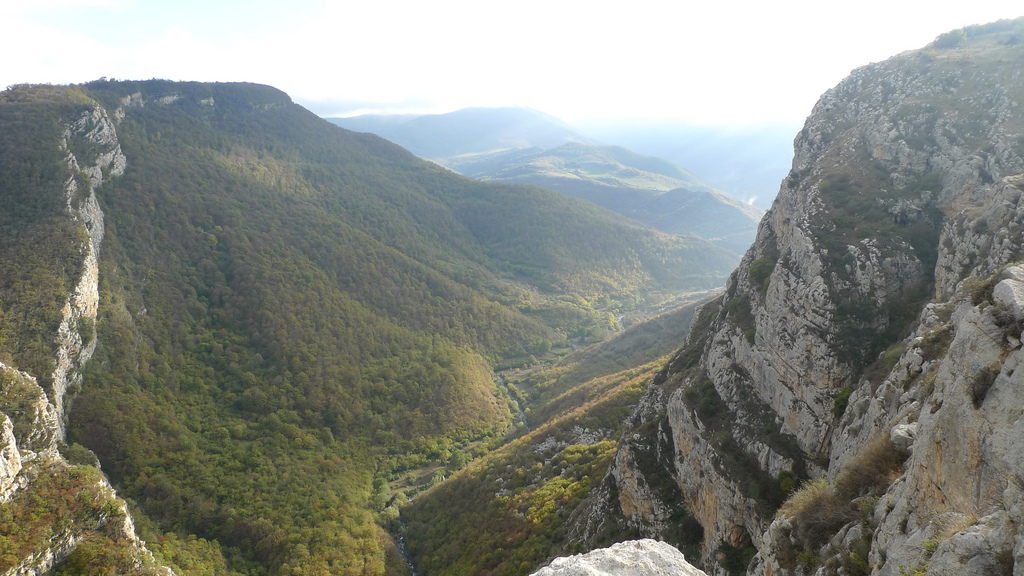Known by the name Artsakh to its present inhabitants and to Armenians, the alternative name Nagorno Karabagh dates from the Khanate of Karabagh's formal entry to the Russian Empire in 1813, nagorno being Russian for 'mountainous'. (karabagh is Turkish for 'black garden'.)
Today Nagorno Karabagh is very predominantly inhabited by ethnic Armenians - they make up around 95% of the population. The language in the streets of its towns is Armenian - albeit with a strikingly different accent - and the banknotes are Armenian. However, it is not part of Armenia: it has its own government with its own foreign ministry, its own flag, its own stamps and its own national anthem. Despite all this, its existence as a state is unrecognised by any other state and no Western government can provide consular services there. It can only be entered from Armenia.
Why go? One answer is that it has some magnificent scenery. It isn't called Nagorno for nothing: even within the pre-1994 boundaries the land rose to 2,725m at Mount Kirs but the incorporation of the territory which formerly separated Nagorno Karabagh from Armenia means that the highest point is now the 3,584m summit of Mount Tsghuk. Other reasons for going are that it has some very fine monasteries, and some thought-provoking damaged streets from which the ethnic Azeri population has fled. There are differences from Armenia. Inevitably, the military presence is more conspicuous.
Travelers to Azerbaijan should be aware of the fact that Nagorno (Mountain) Karabagh is under Armenian occupation. Sadly, the country is dealing with the occupation of over 15% of its land area that is not limited to Karabagh only. Many of the most beautiful villages have been torched and looted to total destruction and anyway, there's no way you can visit from the rest of Azerbaijan. The territories have been completely sealed for more than 20 years now. A bloody war was fought over the region by Azerbaijan and Armenia in the early '90s, just after the Soviet collapse.
In the early 90's, Armenian forces were successful in driving out not only the Azeri military but essentially the entire Azerbaijani population. The region is littered with deserted ghost towns once inhabited by the Azeri settlers.
The enclave declared independence, acknowledged by no one. To this day, it remains a "cold" war zone. But in it's capital, Xankendi (Stepanakert), you would never know it. Although not exactly a major holiday destination, the city has most things you'd expect to find for a place of 50,000+.
Be aware that the subject of Karabagh remains intensely sensitive in both Azerbaijan and Armenia. Attempts at giving what may to you seem a 'balanced' view of the historical perspective, even if apparently harmless and reasonable, may be taken as a pro-Armenian bias given the painful sense of loss that almost every Azerbaijani feels.
Upon arrival in the "capital" Stepanakert, all foriegners must register with the Ministry of Foreign Affairs. They will ask your intenary for Karabagh and give a permit for those regions.
BACKGROUND
Karabagh (Qarabag) is an historical entity considerably bigger than Nagorno Karabagh, the disputed region. Indeed according to the History of Karabagh, 'the first city in the velayat of Karabagh was the fortress city of Barda'. The text continues innocuously enough, to explain that until the Arab invasions, the area was populated by non-Muslim Albanians. Another translator castigates the use of the term Albanians saying it should read Armenians.
A nonsensical but fiercely political debate has raged over such fine points, as politicians try to claim that they can prove that Karabagh is rightfully Armenian or Azerbaijani. From an outsider's perspective, the argument fails at a fundamental level.
The term 'Armenian' was used carelessly by historians and travellers to describe the Christian population, just as the term Tartar was used as a highly inaccurate description of Muslim Azeris. Accurate translation cannot improve historical sloppiness. For much more insight read Thomas de Waal's Black Garden.
GETTING TO KARABAGH
The only way into Nagorno Karabagh at present is via Armenia. Before you go you will need a visa issued by the de facto but internationally unrecognized Karabagh government. This is available for $25 from the Karabagh mission on Moskovian St, Yerevan (three minutes from metro Enta Sardakan). But be aware that the Azeri government considers any such visits to be illegal entry to Azerbaijani territory. Having a Nagorno Karabagh visa in your passport means you won't be issued with an Azeri visa and that you may be refused entry to the rest of Azerbaijan.

If you're planning a trip to Azerbaijan you may be interested ▶ Azerbaijan highlights - For those who prefer to go unbeaten path, to explore less visited places and check national charisma of this small country in Southern Caucasus on the edge of Europe.



